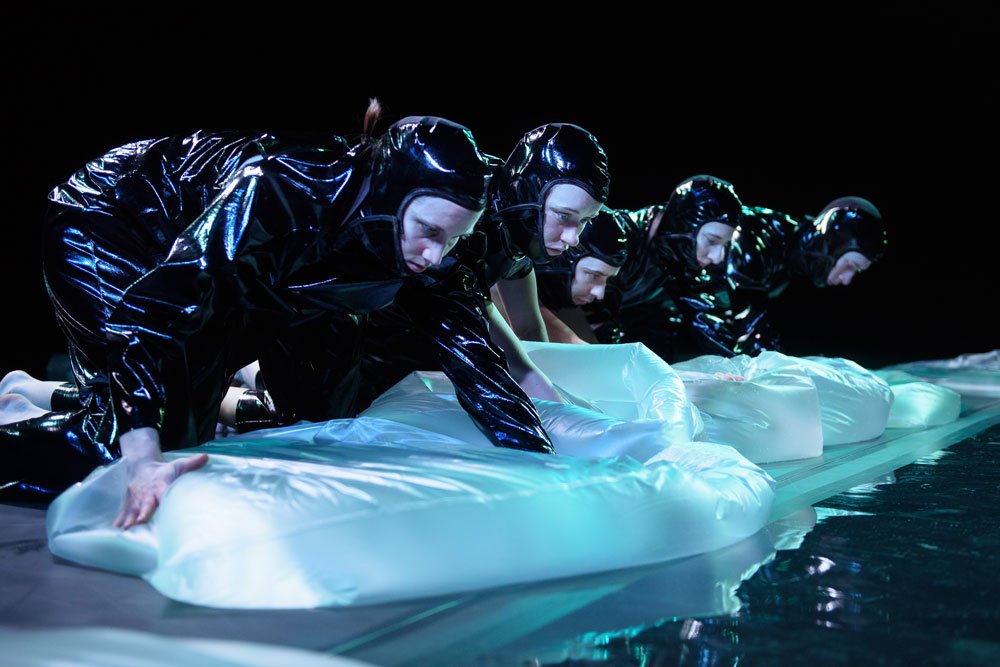Tine Tarpgaard - As I Collapse
*Archive Article: Originally published in the magazine Blacklisted Copenhagen on March 22, 2017
The exploration of various types of ecology through physical work (performance and choreography) is an unavoidable topic of interest within the performative artist’s scene at the moment. Whether this is by sure coincidence, or that the scene itself operates like a global ecology which spreads information from body to body, I can only speculate. The fact of the matter is, the more extroverted ideology of “studying our bodies and the environment as interacting organisms”, rather than the more introverted ideology of seeing the body purely as “vessels for the soul”, is a recurring subject of research.
Now I’m not toting this as a bad thing, in fact, quite the contrary. The reason that everyone seems to have a hard-on for Michael Taussig right now, is that his various anthropological research over the last 35 years has incredible resonance regarding the current state of the human condition.
We need more of this type of reflection and this type of research. I am a firm believer in the idea that change in the mainstream view towards a subject often comes from the artists who risk vilification to explore that subject, research it, bend it, break it, and eventually transform it into something tangible that can be experienced and understood.
Targaard’s work, As I Collapse, is the first installment of a trilogy in which she working with thematic narrative and metaphorical non-human performers, developed from a research based around the subject of ecological sustainability.
Tarpgaard is a seasoned veteran of the Danish choreographic field as co-founder of Recoil Performance Group with composer Pelle Skovmand, and made her name as one of the first choreographers in Denmark to explore the digital in a physical space—often using video, graphics, 3D, installation and film in her work to explore the relation between physical and nonphysical on stage.
With nearly 20 pieces in her oeuvre—many with 5-star success—Tarpgaard has recently begun to forgo the exploration of the digital and technological as subject matter, and switched her focus on the biological and environmental. Her work last year with Live – The Boundless Body a “DIY laboratory where your bacteria gets a new life outside your body” was her first explicit work with Bio, and very well may have been the precursor for another long run of performance successes in that field.
INTERVIEW
Can you tell me a little bit about the concept of As I Collapse?
As I collapse is the first chapter in a row of choreographic works dealing with ecological sustainability. At the center of this work is a desire to contemplate what the anthropologist Michael Taussig calls the impending death – or “Global Meltdown”. This is referring to climate change, overpopulation, and the environmental stress caused by the fact that nothing on this planet is untouched by human existence anymore. Our self-absorption and consumeristic approach to both ourselves and our surroundings seem to be part of the problem.
In ‘As I Collapse’ we have chosen to make a non-human – the algae Pyrocystis fusiformis– the star of the night. Besides its ability to literally shine in the theater darkness, these algae have inspired the creation of movement, scenography, and music and are even present in the hands of the audience.
In the conceptual development of the work, did the research come before the choice of material (movement)? Or vis-a-verse?
All material is founded on the research of the algae and in relation to the environmental subject.
We have been very inspired by Donna Haraway’s latest publication “ Staying with the Trouble”. We have also had various workshops and residencies—for example, the Finnish Bioart Society—finding inspiration in the works of artist and scientist that works with similar subjects.
Eventually, in the studio, our research led to a process of reconsidering the human body and identity through movement. How can we attempt to restructure our bones? Or attempt to turn our body into liquid? This certainly led to very special movements, but it was also a process that was interesting in terms of how we perceive both ourselves, the world around us, and other beings in it.
Because this piece is the first in a trilogy, are you working from a narrative or storyline, or is it more of a thematic trilogy?
It is for sure a thematic trilogy. The complexity of working with non-human actors is quite evident. Ethically there is always the challenge that the “desire” for generating this meeting is that of the human. The algae did not choose to be on stage, for example. So our dedication to enter into this work and subject requires thorough work on formats and methods in our practice. With this trilogy, I am unfolding three different forms – all dealing with the entanglement of the human and non-human.
How does this piece play into the larger role of the trilogy?
In “As I Collapse” we have chosen to work with our unusual actor in a recognizable frame: the stage on which you as an audience gaze on the spectacle in front of you. Only this time it is both algae and dancers performing for you.
Apart from being present on stage – sometimes very visible through their light, sometimes as water moving on stage – the algae has also been the starting point and inspiration for the development of the movement material, light, scenographic elements, and sound.
In dealing with “life” you also deal with death. So there is definitely a factor of caretaker and to succeed in care taking – that has been very distinct for the work with “as I collapse”. It is also rewarding and you develop a very special relationship with these tiny companions.
You get to realize that you have to be aware of their daily rhythm. They will only respond to your touch with light when they think it is nighttime. So – let's say – we have a school performance at 12 – that means that we need to adjust their daily rhythm. Also if you stress them too much with the motion they get tired and will not perform.
You state that the work is “a speculative fictional universe that stages bodies in microscopic format and in human size.” Can you elaborate on this?
One of the things that seemed relevant when working with a de-centering of the human in surroundings that usually favor humans, was working with different scales. We perceive the world from a human-scale perspective, but even though the microscopic scale in our daily life is invisible to us, it is obviously as important to the balance of the environment. So making aware of scale became us a method of which to generate attention the other than human perspectives.
Relating to the part of our environment that is usually invisible to the naked eye requires imagination. Our ability to imagine or speculate on potential futures is also very present in our perception of environmental challenges. In “as I collapse” we have our bodies engaged in experiencing other ways of being – “making” up a space where rules of movement are different for both humans and algae.
Would you say this piece is statement-based or exploratory? In order words, is there a particular question that you are asking in this piece, or a statement that you are making? I am not really so interested in making statements, but I hope to inspire and offer our audiences new objectives to see though.
It is my hope that this performance by introducing the audience to one of our tiny algae companions in an unusual way, can inspire us to think anew about our relationship with the world around us.









